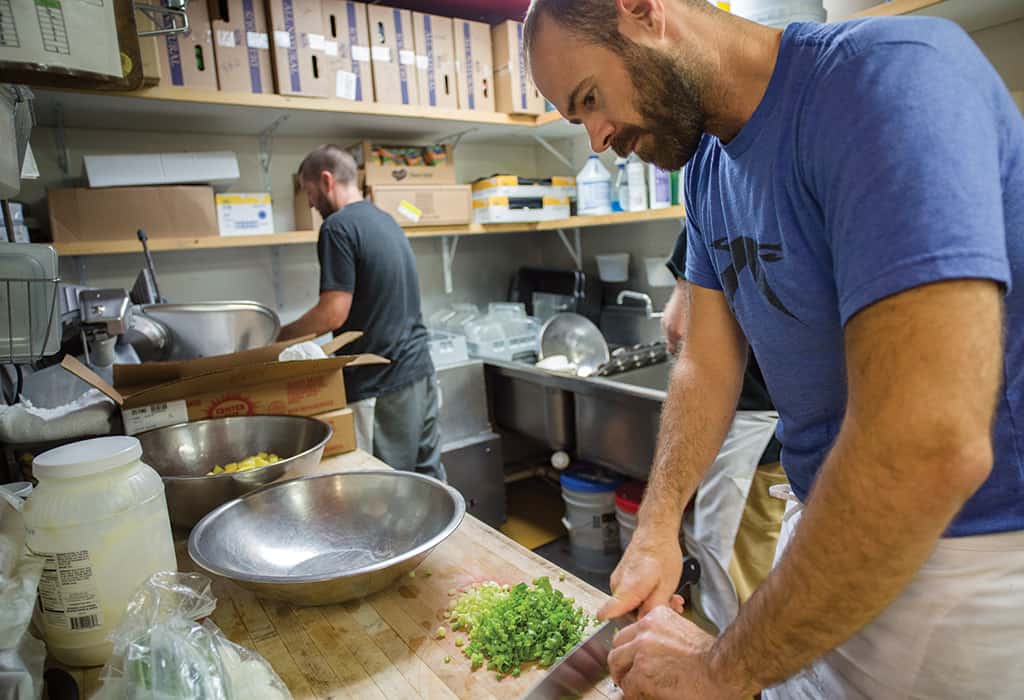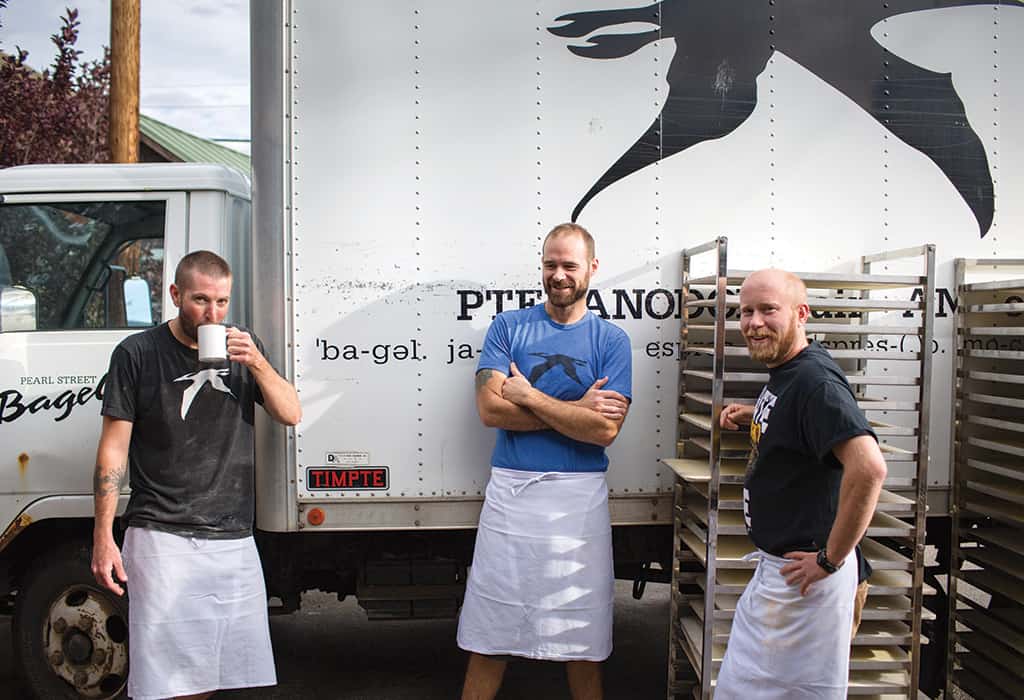Read The
Current Issue
Baking Bagels
Pearl Street Bagels doesn’t toast their bagels because a crew of bakers makes them fresh all day long.
By elizabeth hochrein
PHOTOGRAPHY BY David stubbs

THE SMELL IS intense. Make that Intense. Capital I. If the beginning of life had a smell, it would be like the one wafting in the kitchen of the downtown Pearl Street Bagels location—a mixture of moisture, yeast, and malt that is primordially fertile. Walking into this kitchen is like walking into a loaf of fresh bread. In addition to the smell, the small space is hot, anywhere from 80 degrees to 90-something, depending on the season. Even when it’s zero degrees outside, opening the back door can only do so much against a 400-degree oven.
Seven days a week, 363 days of the year, two to three bakers at a time work together here to churn out between six hundred (winter) and nine hundred (summer) bagels a day. One comes in at 4:30 a.m. to bake the first four batches of bagels that baristas sell starting at 6:30, when the shop opens. The second shift, a prep shift, starts at a relatively more reasonable time, between 7 and 8 a.m. When asked about what happens if the employee on the bake shift oversleeps, Ryan Coleman, who worked as a baker until last September, said, “I don’t know of anyone ever missing their bake shift. I’ve come in still stumbling around from the night before, but I’ve come in. When I’m on a bake shift, I try to get to bed at ten o’clock the night before, but that rarely actually happens. Something often ends up keeping me from sleeping.”
Maggie and Les Gibson founded Pearl Street Bagels (PSB) in 1990. While in college in Burlington, Vermont, Maggie was introduced to real bagels and learned how to make them. After several years in Jackson Hole, she began missing bagels enough that she decided to make them herself. Pearl Street Bagels was an instant hit. In 1996, the couple opened an outpost in Wilson. For eighteen years, Maggie and/or Les could be found in one of the two locations most every day. And then it was time for them to move on.
In 2008, three PSB employees—Brevan Daniel (kitchen manager), Polly Danz (Wilson manager), and Heather Gould (office manager) purchased the business. (As of last September, Danz and Gould bought Daniel out.) Aside from Maggie and Les no longer being around, customers noticed little difference after the sale. Pearl Street Bagels still made the best bagels in the valley, was a great space for aspiring local artists to show their work, had some of the friendliest baristas around, and refused to toast bagels, instead baking them fresh throughout the morning.

WHEN MATT BERUBE comes in at 4:30 a.m. for the bake shift, his responsibilities include the first bake, making the first round of breakfast sandwiches, and baking all of the cookies.
Walking into the kitchen, Berube, who’s been baking bagels for two and a half years and is also now the assistant kitchen manager, finds the kettle and oven hot and nearly ready to go; both are on a timer. Also ready is the bagel dough, which has already been formed, put on racks, and stored overnight in the refrigerator. Berube gets to boiling, the first step. All true bagels are boiled for a couple of minutes before being baked. If a bagel is not boiled, it will be “dull in appearance,” Gould says. Unboiled bagels are also chewier all the way through and lack the satisfying crunch of a boiled bagel’s outer shell. “I believe most people would say that boiling a bagel before baking it is what makes it a ‘real’ bagel,” Gould says. “This is definitely how they do it in New York City, and New York bagels are still the gold standard to which all others are compared.”
PSB’s kettle has the capacity to boil a couple hundred bagels at a time; it holds seventy-five gallons of water. A petite adult woman could easily stand in it. But, because only seventy-two bagels at a time fit onto the boards that then go into the oven, only seventy-two bagels are boiled at a time. “This is the step where a lot of the artistry comes into the baking process,” Gould says. “The bakers get to know how different dough reacts, when it is new versus older, over- or underproofed, or any number of other variations between batches. They’ll see what’s up and adjust the boiling and then the baking times accordingly.”
Berube rescues the bagels, cheerfully bobbing in the roiling boil, from the kettle with a giant perforated scoop and efficiently lines them up on a burlap-covered board. The board then goes into the 400-degree oven. They are baked for about five minutes before Berube flips them off the board and onto the open oven shelves. The boiled dough needs to be started on boards so the outside of the bagels can harden just a bit. Otherwise, the dough would stick to the oven shelf. Once flipped, the bagels rotate on the shelves for another ten minutes or so. After that, they are ready to serve—scooped into wire bins and brought to the front of the house, where the line of customers stretches out the front door. The most popular flavors at PSB are everything, cinnamon raisin, and plain. “Depending on how busy we are, when I’m baking, I’m usually out of here at one o’clock or two. Sometimes three o’clock, if we’re really busy,” Berube says. “That’s one of the perks of the job. You get your work done and have afternoons free.”

THAT’S JUST THE bagel baking. You have to have dough to bake. In the winter, bakers make dough three days a week. In summer, it’s four days a week. The downtown location makes the bagel dough for the Wilson location as well, but all of the bagels sold in Wilson are baked and boiled there.
The mixer is as big as the kettle. Each batch of dough includes one hundred pounds of flour, malt, salt, and yeast and about twenty pounds of water. This makes enough dough for six hundred bagels, which fills one rack. In the winter, the goal is to make four racks on each dough-making day. Once the dough is mixed, it goes into the “bagel machine.” “Technically, it’s called an automatic divider/former; we just call it the ‘bagel machine,’ though,” Gould says. This machine does what its name suggests: it forms blobs of dough into bagels, each perfectly round with a small hole in the center. It does this at the rate of thirty bagels a minute. “Catching them is mindless, but you have to be on it,” Coleman says.
The bagel machine has to be on it, too. “When we bought the business, we were using the original machine that Les and Maggie had bought used in 1990,” Gould says. “It had developed lots of issues, which made dough days very stressful. There aren’t many people around here who work on them, so our bakers have figured out how to solve any glitches that arise. It is high-stakes. Since we’re a bagel shop, having bagels is pretty basic!” A new bagel machine was bought several years ago, “but it came with new and different issues,” Gould says. “It took some getting used to, but the bakers are able to troubleshoot any issues that arise really well now.” All three of the current bakers—Berube, newbie Nelson Jones, and Bob Sanders, a baker for fifteen years and also the kitchen manager—are comfortable tinkering with the machine, but Gould says Sanders is the bagel machine whisperer.
After being formed, trays of raw bagels go into the proofer for about ten minutes. In here, the dough rises. Once done in the proofer, they go into the chilled storage area until tomorrow morning’s baker comes in. “The dough we make today is for tomorrow and the day after,” Berube explains. “Dough can last longer, but we can only make as much as we have room to store, and that’s not that much.”

Once it becomes apparent to me that Coleman isn’t going to miss a bagel coming down the bagel machine’s treadmill—resulting in a bagel version of the famous I Love Lucy chocolate factory scene—I decide I’d rather enjoy a bagel out front than stand beside him for the twenty-some minutes it takes to fill a rack. Since Pearl Street doesn’t toast bagels, I go with what is freshest. The sesame bagels aren’t merely fresh but still hot. The barista slices one in half and then half again. Steam rises when she pulls the halves apart, proving that fresh is indeed better than toasted.




